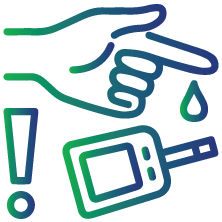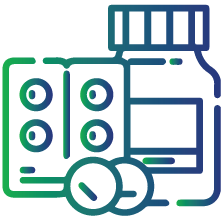
Alanine Amino-transferase (ALT) SGPT Test
About alanine amino-transferase (ALT) test
Alanine transaminase (ALT), also known as alanine aminotransferase is an enzyme that helps break down proteins. It is primarily found in the liver but can also be found in other parts of the body such as the kidneys.
The alanine transaminase (ALT) blood test is used to measure the amount of ALT enzyme in your blood. Because ALT levels in the blood can rise when the liver is damaged, ALT blood test is used to assess liver health.
Many types of liver problems can cause elevated ALT levels; therefore, this test is not used to diagnose a condition and is included as part of a similar blood tests panel such as Comprehensive Metabolic Panel (CMP) or Liver Enzyme Panel (HFP or LFT).
Thus, getting your liver function test done is recommended to screen and monitor liver diseases.
This test is also known as
Serum Glutamic-Pyruvic Transaminase (SGPT), GPT, Alanine aminotransferase (ALT)
Symptoms of liver disease
The symptoms of liver disease include

Jaundice

Nausea and vomiting

Abdominal pain

Dark-coloured urine

Light-coloured stool

Fatigue

Loss of appetite

Swelling in the legs and ankles

Frequent itching
When should someone get tested?
An ALT test is recommended in individuals who have a high risk for liver damage because of

Family history of liver disease

Excessive consumption of alcohol

Obesity

Diabetes

Medicines leading to liver damage

Hepatitis or exposure to hepatitis virus
Preparation for the test
There is no special preparation required for the ALT blood test. However, an ALT test is usually ordered along with other blood tests. Some liver panel blood tests require fasting for up to 12 hours before the test, only drinking water is recommended during this time. Some medications can also affect the liver, so ensure your doctor is aware of what prescription drugs, over-the-counter medicines, or dietary supplements you are taking. Ask your doctor for details about pre-test preparations, and follow the instructions closely.
Interpretation of results
|
Parameters |
Normal liver function test values |
|
ALT (SGPT), Serum |
< 50 U/L |
Normal ranges may vary slightly between laboratories, and some laboratories use different measurements.
Deviation from normal levels indicates the following:
· Very high level of ALT (> 10 times the normal level) is usually caused due to acute hepatitis as a result of viral infection.
· High level of ALT (4 times the normal level) is usually caused due to chronic hepatitis, biliary obstruction, or cirrhosis.
· In most liver diseases, ALT is higher than AST and the AST/ALT ratio is low (<1). AST/ALT ratio greater than 1 is usually caused due to alcoholic hepatitis, cirrhosis, heart or muscle injury.
FAQs
What happens during an ALT test?
A blood sample is taken from a vein in the arm using a fine needle. Usually, this process takes no more than 5 minutes.
What are the risks associated with an ALT test?
This test involves negligible risk of infection. There might be slight bruising or tenderness around the site where the needle is inserted.
Does high ALT level always mean liver damage?
Several conditions can affect the results of ALT test. Multiple factors like medications, immune conditions, intense exercise, etc. can lead to abnormal ALT test result. Therefore, high ALT level does not always mean severe liver disease.
What should you do if you have an abnormal ALT test result?
An abnormal ALT test result can indicate liver damage caused due to conditions like hepatitis, cirrhosis, tumour, hemochromatosis, mononucleosis, etc. The ALT test results are used to help diagnose your condition or determine the appropriate treatment for you. In some cases, this blood test is not enough to diagnose specific liver disease and requires further tests, like imaging tests, a liver biopsy, or blood tests for certain viruses to help make a final diagnosis. Your healthcare provider will devise a treatment plan for you based on your diagnosis.
How to lower elevated ALT levels?
You can maintain your ALT levels by limiting alcohol intake, avoiding consumption of saturated/ trans fats, having an active lifestyle, and adding more folate-rich foods like leafy greens, bananas, and legumes to your diet.

